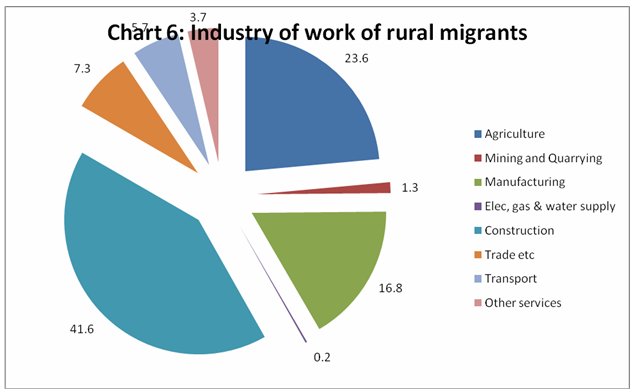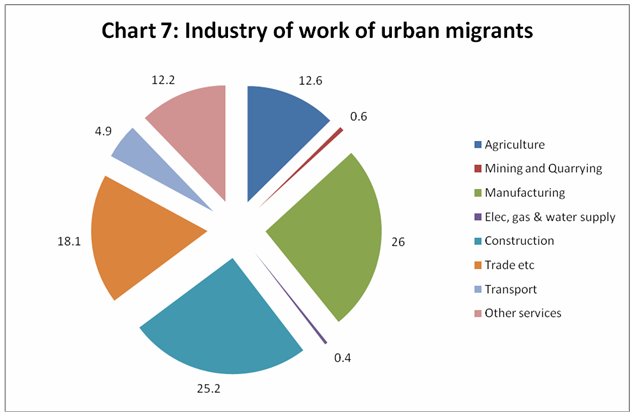One of the important features of labour markets and
working conditions of workers in India that has always
been inadequately captured by our statistical system
is economic migration. The Census data collection
exercise is concerned only with current residence
and permanent migration. It does not even attempt
to capture short-term of seasonal flows of people,
and - because of its rather strict definition of permanent
migration - it even tends to leave out fairly prolonged
periods of migration.
The
National Sample Survey Organisation, until recently,
had also tended to ignore short-term migration. In
the 55th Round survey conducted in 1999-2000, some
questions were asked about those who worked away from
their normal residence for more than three months,
and this did provide some hints of evidence about
short-term migration for work. But micro studies indicated
that much of such movement is even more short-term
and often seasonal in character, and this was simply
not captured. The next large survey of 2004-05, the
61st Round, did not address the issue of migration
at all.
That is why the results of the 64th Round survey conducted
in 2007-08, with a special focus on migration, were
so eagerly awaited. Although it was a “small” survey
(the most recent large NSS survey was conducted over
2009-10), it was nevertheless large enough to give
us some useful indicators about some national and
state-level trends with respect to this feature. One
again, migration for work is only a subset of the
questions that were addressed, but the greater depth
of the questions and the revision of the time period
of movement with respect to which questions were asked
do provide some more data.
The basic trends in permanent or longer term migration
that are indicated from that survey are shown in Chart
1. There is a significant increase in migration rates
for females, but for urban males the rates are stagnant
and those for rural males have even declined somewhat.

Chart
1 >> Click
to Enlarge
It is well known that the dominant
proportion of female migration in India is for purposes
of marriage, since most marriage patterns in the country
are based on virilocal residence. More than 91 per
cent of rural female migrants and 61 per cent of urban
female migrants had moved because of marriage. This
also explains why most of the migration (more than
90 per cent) in India is permanent in nature. Another
30 per cent of urban female migration was accounted
for by the need to move because the head of household
or main earning member had moved.
Since
female migration rates remain so strongly determined
by marriage, it is likely the male movement will better
capture changing trends. Therefore Charts 2 and 3
provide the evidence on changing migration rates of
rural and urban males, respectively, by broad social
category.

Chart
2 >> Click
to Enlarge
This is where the story becomes interesting. The latest
NSS survey actually shows a significant decline in
rural male migration rates (Chart 2), on average by
as much as 28 per cent compared to the previous survey.
The drop is evident across all social categories,
though it is largest for the SC and OBC categories.
This is possibly the first time that such declines
have been shown in the aggregate survey data, and
if this is a correct representation of reality it
is also likely to have implications for many other
trends, such as urbanisation and changing demographic
structures across different regions. Rural to urban
male migration increased by about 5 percentage points
compared to the previous survey, but it still accounted
for less than 40 per cent of total male migration.
It
is also worth noting that such declines in migration
rates are not evident for urban males (Chart 3). In
fact, while migration rates for urban males of the
ST and OBC categories decreased to some extent, they
increased for SC and general categories, such that
the average rate increased slightly. One quarter of
all male migration was from one urban centre to another.

Chart
3 >> Click
to Enlarge
Similar
surprises are evident in terms of the causes of migration,
as shown in Chart 4. Work-related reasons (dominated
by the search of new or better employment) actually
accounted for falling proportions of the moves made
by rural residents, both male and female, even as
they continued to increase for urban males.

Chart
4 >> Click
to Enlarge
This is without question a noteworthy
development. What explains this trend? This issue
needs to be explored in much more detail, and with
more investigation into regional characteristics.
But it is possible that the introduction of the NREGA
has played some positive role in preventing the extreme
distress migration that was observed to characterise
many rural parts of the country.
Of
course, 2007-08 was still an early year for the programme,
which had not yet been extended to all the rural districts.
We may have to wait for the latest NSS survey to provide
some more information on this. The impact on rural
employment would be felt not only in terms of the
direct employment effects but also through the multiplier
effects of the incomes earned on what has been a very
depressed rural economy.
And of course, it is also possible that in addition
to positive factors, adverse features - such as the
fact that our urban areas have become less welcoming
or even tolerant of rural migrants - may also have
been significant. But certainly this survey shows
that even short-term migration, of between one to
four months, was relatively low and had probably decreased
since the previous survey.

Chart
5 >> Click
to Enlarge
On
thing is clear though: once they move, migrants are
more likely to look for jobs and to find them (Chart
5). This is true of all categories of migrants, and
holds true whether they move for work-related reasons
or for any other reason. However, the survey also
shows that a growing proportion of the work that migrants
find is in the form of self-employment, indicating
the continuing difficulty in our growing economy,
of finding paid employment.
Construction
remains by far the dominant employer for rural migrants
(Chart 6) though agriculture accounts for the activity
of nearly a quarter. Manufacturing accounts for only
about 17 per cent of rural migrants’ work, a declining
proportion compared to the previous survey.

Chart
6 >> Click
to Enlarge
For
migrants from urban areas, construction and manufacturing
account for around equal shares of the activity (Chart
7) - amounting to just over half the work found. Trade,
hotels and restaurants are the other large employers
of migrants from urban areas.

Chart
7 >> Click
to Enlarge
There is obviously a great deal
more that is revealed by this latest migration survey
of the NSS, including the type of work, the remittances
sent, the details of the short-term employment, and
so on. But the early results already suggest that
there are some important changes in the pattern of
movement for work, especially for rural residents.
We need to consider more systematically how much this
is related to patterns of public intervention, and
also how public policy should address these changes.

